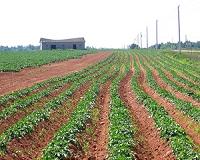 |
West Lafayette IN (SPX) Jan 27, 2011 Many of the genes that allow wheat to ward off Hessian flies are no longer effective in the southeastern United States, and care should be taken to ensure that resistance genes that so far haven't been utilized in commercial wheat lines are used prudently, according to U.S. Department of Agriculture and Purdue University scientists. An analysis of wheat lines carrying resistance genes from dozens of locations throughout the Southeast showed that some give little or no resistance to the Hessian fly, a major pest of wheat that can cause millions of dollars in damage to wheat crops each year. Others, even those considered the most effective, are allowing wheat to become susceptible to the fly larvae, which feed on and kill the plants. Wheat resistance genes recognize avirulent Hessian flies and activate a defense response that kills the fly larvae attacking the plant. However, this leads to strains of the fly that can overcome resistant wheat, much like insects becoming resistant to pesticides. "The number of genes available to protect wheat is limited. There really aren't that many," said Richard Shukle, a research scientist with the USDA Agricultural Research Service Crop Production and Pest Control Research Unit and Purdue adjunct associate professor of entomology. "In the Southeast, having multiple generations of Hessian fly each year enhances the ability of these flies to overcome wheat's resistance." Sue Cambron, a USDA Agricultural Research Service research support scientist, received Hessian flies from 20 locations in Alabama, Georgia, North Carolina, South Carolina and Louisiana and used them to infest 21 varieties of wheat that each contained different resistance genes, most of which have been deployed in commercial wheat, and a few that haven't yet. While the study did not include all of the 33 named resistance genes, it did show that only five of the 21 genes evaluated would provide effective resistance to flies in the Southeast, and none was effective in all the Southeast locations. "Even some of the newer genes that haven't been deployed in cultivars weren't too effective," Cambron said. That's because flies have likely interacted with, and adapted to, those genes already, said Brandi Schemerhorn, a USDA-ARS entomologist and Purdue assistant professor of entomology. She said it's possible that some of the genes were introduced to flies unintentionally in plots where wheat cultivars with those genes were being tested for suitability to Southeast climates. The resistance genes also could have come from other plants, such as rye, and the flies may already have started to overcome those genes. Schemerhorn said she suspects a certain number of flies in any population have the ability to overcome any wheat resistance gene, which defends against the flies' ability to feed on the plant and starves the insect larvae. When a resistance gene kills off some of the flies, the survivors breed and eventually establish a population that renders the gene ineffective. "We're creating a system in which the fly is becoming more virulent," Schemerhorn said. "What we have to do is slow down that adaptation or virulence." Shukle and Schemerhorn suggest stacking genes in a wheat cultivar. There are only a few genes that haven't been deployed, and they believe combining two of those would be the best option. "With a small number of identified resistance genes, we can't afford to release wheat lines with only one resistance gene," Shukle said. "If you deploy two different resistance genes, it's unlikely that a population of flies could overcome both of them." Schemerhorn is working to combine two of the unreleased genes for testing with Hessian fly populations. The USDA funded the research. Shukle, Schemerhorn and Cambron collaborated with David Buntin, a University of Georgia professor of entomology; Randy Weisz, a North Carolina State associate professor of crop science and small grains specialist; Kathy Flanders, an Auburn University associate professor of entomology; and Jeff Holland, a Purdue associate professor of entomology. Their findings were published in the Journal of Economic Entomology.
Share This Article With Planet Earth
Related Links Purdue University Farming Today - Suppliers and Technology
 Toward Controlling Fungus That Caused Irish Potato Famine
Toward Controlling Fungus That Caused Irish Potato FamineWashington DC (SPX) Jan 21, 2011 Scientists are reporting a key advance toward development of a way to combat the terrible plant diseases that caused the Irish potato famine and still inflict billions of dollars of damage to crops each year around the world. Their study appears in ACS' bi-weekly journal Organic Letters. Teck-Peng Loh and colleagues point out that the Phytophthora fungi cause extensive damage to food ... read more |
|
| The content herein, unless otherwise known to be public domain, are Copyright 1995-2010 - SpaceDaily. AFP and UPI Wire Stories are copyright Agence France-Presse and United Press International. ESA Portal Reports are copyright European Space Agency. All NASA sourced material is public domain. Additional copyrights may apply in whole or part to other bona fide parties. Advertising does not imply endorsement,agreement or approval of any opinions, statements or information provided by SpaceDaily on any Web page published or hosted by SpaceDaily. Privacy Statement |